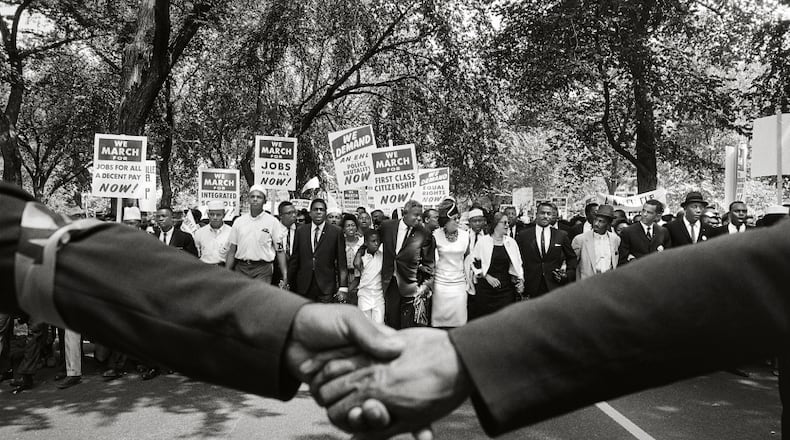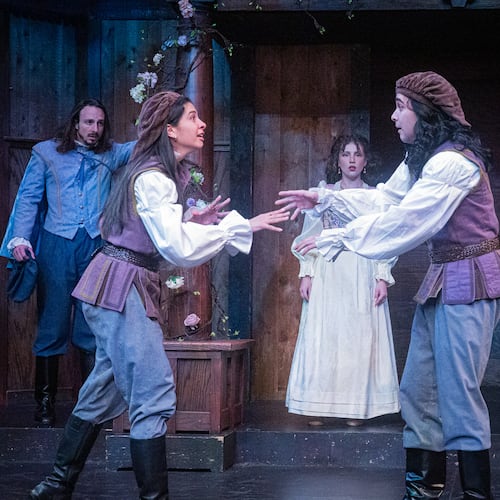More than 55 years separate the photographs of Steve Schapiro and Sheila Pree Bright, but their images are kindred.
Take the picture Schapiro took in Selma in 1965. In the photo, an older Black woman stands in a crowd of other Black people clearly waiting for something. She is bundled up against the cold, with a hat and scarves and her overcoat appears sprinkled with rain. Her face doesn’t reflect discomfort so much as determination. The sign she holds in her bare hands reveals why, and its message is stark and clear: “Stop Police Killings.”
Credit: Jackson Fine Art
Credit: Jackson Fine Art
Then consider Pree Bright’s photo made 50 years later. A crowd in Ferguson, Missouri, is marching down a street. One of the female marchers carries a huge United States flag, hung upside down on a pole in her right hand. Flying the flag upside down is understood as a symbol of distress or danger. The marchers are protesting police killings of unarmed Black people in the city where Michael Brown was gunned down by a white police officer just a year before Pree Bright took the photo.
Credit: Steve Schapiro
Credit: Steve Schapiro
To view the photos together is evidence of a national problem that has rolled from one generation to next, unsolved. That’s what viewers will be asked to consider in the new show at Jackson Fine Art in Buckhead, featuring the work of Schapiro and Pree Bright. “Steve Schapiro: In Celebration of the Fire Next Time,” and Pree Bright’s series “#1960 Now” both are witnesses to two of the nation’s most important racial reckonings: the civil rights movement of the 1960s and the protests against police killings of unarmed black people in the early 2000s. Except for one, all of the images are in black and white, documentary in approach. The show runs now through Sept. 19 and can be viewed in person or virtually.
For Jackson Fine Art, the work currently on view is a departure in terms of subject matter. It is not known as a showcase for protest photography or for local Black photographers who otherwise have national followings. But after the police killing of George Floyd and waves of international protest that ensued, gallery owner Anna Walker-Skillman decided she couldn’t look away and neither should visitors.
“It hasn’t been something I’ve done regularly, and I’ve been in this gallery since I was 27 years old,” said Walker-Skillman. “I’m 50 years old.”
Though she didn’t want the show “to be reactive,” she said, she did want to recognize the moment. She had not shown the work of Pree Bright before, an Atlanta-based, Black photographer whose work has been shown nationally and featured at the High Museum. Pree Bright’s images have long spoken to Black identity, from notions of beauty to stereotypes about the Black middle class. A few years ago, she began taking pictures of lesser-known but important civil rights figures such as Lonnie King, Jr., a founder of the 1960 Atlanta Student Movement and Dr. Roslyn Pope, author of “An Appeal for Human Rights.” That series was called “1960 Who”.
After the killing of Brown in Ferguson, Bright immediately saw the through line between that series and what was happening on the ground in Ferguson. After the death of Freddie Gray in Baltimore while he was in police custody and the protests that ensued, Pree Bright got on the road.
“There were so many deaths going on, I couldn’t keep up with it,” Pree Bright said. “I was in Baltimore. I was in Ferguson. I was in Baton Rouge.”
Credit: Sheila Pree Bright
Credit: Sheila Pree Bright
The gruesome fact that this body of work remains ongoing is not lost on her. Four images from that period are featured in the show. The one outlier is the photo composite, “The Rebirth of Us,” an homage to the mothers of the victims in the Atlanta Child Murders case of the late 1970s and early 1980s. A burst of sunflowers, each representing one of the missing and murdered children surrounds the haunting and elegant blue face of a Black woman meant to symbolize the mothers. Her gaze is open and almost warm. Thematically, it’s a discordant image in the show, as if the weight of Black suffering captured in real time could be too much for some viewers to bear.
Schapiro’s work is a reminder of just how long that suffering has lasted. Schapiro was on an assignment for Life Magazine in the early 1960s, on a story he pitched after reading James Baldwin’s 1962 essay, “Letter from a Region in My Mind,” in The New Yorker magazine. The essay became one of two that became the classic Baldwin book, “The Fire Next Time.” After the New Yorker essay was published, Schapiro traveled with Baldwin throughout the South in 1963 and saw the effects of segregation up close. Through Baldwin’s involvement in the movement, Schapiro met the people fighting American apartheid below the Mason-Dixon line.
“Suddenly, to see everything in person was very disturbing,” Schapiro said. “We visited Medgar Evers in Mississippi at his house, and he put a towel over the rental car license plate, almost as a joke, because he knew his house was under surveillance.”
Evers was assassinated in his driveway by a white supremacist later that year.
Schapiro continued to document the movement capturing some of its most pivotal moments and leaders. He captured an image of John Lewis as a young activist in Clarksdale. He covered the final and successful march from Selma to Montgomery in 1965 that led to the Voting Rights Act of the same year. And he was one of the few to enter Martin Luther King, Jr.‘s room at the Lorraine Motel in Memphis just hours after King was assassinated.
Credit: Steve Schapiro
Credit: Steve Schapiro
Many of Schapiro’s photographs were included in the 2017 reissue of “The Fire Next Time.” Several of them were never published by Life magazine. Like the photo of the woman in Selma holding the “Stop Police Killings” sign.
“My lady holding the sign was incidental to the big story, at the time,” Schapiro said. “This was not a major picture in terms of news. It takes time for people to see that.”
Yet the message of the sign endures, visible on streets across the nation during this summer of protest.
EXHIBIT PREVIEW
“Steve Schapiro: In Celebration of The Fire Next Time” and Sheila Pree Bright’s “#1960Now”
Through Sept. 19.
Jackson Fine Art Gallery, 3115 E Shadowlawn Ave. NE, Atlanta. 404-233-3739, jacksonfineart.com.
About the Author
Keep Reading
The Latest
Featured






